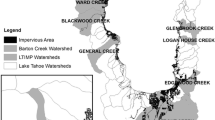Abstract
Data for over 100 watershed properties, including aspects of topography, hydrology, geology, soils, vegetation, lake morphometry and input precipitation chemistry, have been developed since 1980 for 316 watersheds in northern Wisconsin. The hypothesis being evaluated for this lake population is that the observed water chemistry, can be accounted for as a function of antecedent water and chemical inputs, after considering exchange processes in the lake and watershed and the lake/groundwater interactions. The variables found by regression analysis to explain observed variability in color, sulfate, and acid neutralizing capacity (ANC) levels in Wisconsin lakes are: for color, vegetative characteristics, mean depth, and water renewal times; for sulfate, precipitation concentration of sulfur, evaporative concentration, and lake water renewal time; ANC appears to be controlled by the size of the watershed, lake depth or water renewal time, and the intensity of anthropogenic inputs and cultural developments in the watershed. These results differ from previous studies in Wisconsin and nearby areas of Michigan and Minnesota by indicating that in some lakes acidity may not be in equilibrium with current precipitation chemistry.
Similar content being viewed by others
References
Chen, C.W., Gherini, S.A., Hudson, R.J.M., and Dean, J.D.: 1983,The integrated lake-watershed acidification study. Model principles and application procedures. Electric Power Research Institute, EPRI EA-3221, Palo Alto, CA.
Eilers, J.M., Glass, G.E., Webster, K.E., and Rogalla, J.A.: 1983,Can. J. Fish. Aquat. Sci. 11 1896.
Glass, G.E., and Loucks, O.L.: 1986,Environ. Sci. Technol.,20, No.1, pp. 35–43.
Glass, G.E., Sorensen, J.A., Liukkonen, B.W., Rapp, G. Jr., Loucks, O.L.: 1986, This volume.
Likens, G.E., et al.: 1977,Bio-Geo-Chemistry of a Forested Ecosystem. Springer-Verlag, N.Y., Berlin, Heidelberg, pp. 148.
Rapp, G., Jr., Allert, J.D., Liukkonen, B.W., Ilse, J.A., Loucks, O.L., and Glass, C.E.: 1985,Environ. International 11 425.
Rapp, George, Jr., Liukkonen, Barbara W., Allert, James D., Glass, Gary E., and Loucks, O.L.: 1986,Geologic and Atmospheric-Input Factors Affecting Watershed Chemistry in Upper Michigan. In Press, Environmental Geology.
Schnoor, J.L., and Stumm, W.: 1984, “Acidification of Aquatic and Terrestrial Systems.” InChemical Processes in Lakes. W. Stumm (Ed.), Wiley Interscience, New York, N.Y.
Stauffer, R.E.: 1985,Envionr. Sci. Technol., 19 405.
Author information
Authors and Affiliations
Rights and permissions
About this article
Cite this article
Loucks, O.L., Glass, G.E., Sorensen, J.A. et al. Role of precipitation chemistry versus other watershed properties in Wisconsin lake acidification. Water Air Soil Pollut 31, 67–77 (1986). https://doi.org/10.1007/BF00630820
Issue Date:
DOI: https://doi.org/10.1007/BF00630820




